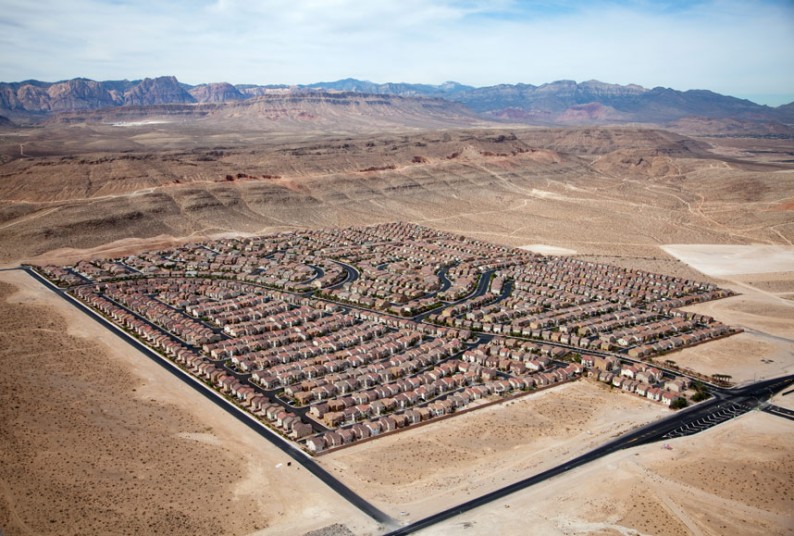I’ve written before about the first photo below, but today another image prompted a second look.
This is an aerial view of the Za’atari refugee camp near the Jordanian city of Mafraq, some five miles from the border with Syria. As of July, it housed 144,000 refugees. In the desert. But for the lack of little things like trees, it could almost be mistaken for the grid plan of Chicago that you see when flying into O’Hare. The rectilinear neighborhoods and long arterials, including a few on the diagonal, are evidence of good urban planning. Density is given legible units while access to services is managed efficiently. The urban core remains a vital center of administration, while continued growth can spread in long rows of housing and distribution facilities across the plain. Close your eyes and you can almost imagine the desert blooming with suburbs and malls.
I wouldn’t want to bet that no one has floated such insanity as a development option for Za’atari, but of course the reality on the ground is hardly the stuff of either comedy or fantasy. This is a slow moving tragedy in the making, a catastrophe hardening into something like a permanent condition, yet one where those living there will have to approach every day as a struggle, every day as an endurance test that can push them to the limit of resourcefulness, and yet never to get ahead, improve their lot, escape to a place where they can have a future instead of another day, month, year of harsh fatality.
Camps can become cities, as those in the Occupied Territories, Pakistan, Thailand, and elsewhere know all too well, but they never become cities like Chicago, or Peoria for that matter. Za’atari currently is the fourth largest city in Jordan, but I don’t think you will read about it soon in either the business or travel sections of the newspaper.
And I’ve said this before, so why bring the photograph up again? One of the conditions of photography is that there always is another photo to replace the one before, always another image of another disaster. Both the events and the images are produced by powerful forces shaping the modern world, and they seem to run together into one long-running humanitarian movie. Refuge World, with a cast of 45,000,000, coming to a theater near you. And we know how effective that would be. So, what’s new about refugee camps?
Well, perhaps it’s notable that they are being built in Las Vegas. And I don’t mean the detainment centers for deportees–that’s another, sadder story. Today I’m talking about this “desert housing block,” which is not–despite the label–a prison. But it doesn’t it look somewhat like that camp in Jordan? Sure, it’s neater, more compact, and affluent (you can see that even at this distance), but you can observe the same design principles, the same harsh environment, the same geographic isolation. In fact, the most obvious difference is that this looks more like a camp–even a Roman military encampment–while the camp looks more like a city. But guess which one will have all the rights, powers, and privileges of a city?
I think both photographs are shocking, not least because of how each reprises and bleeds into the other. The camp should not be so large and well organized, so close to becoming a permanent city. The city should not be so isolated and placed in such a barren, arid environment. The camp should not look so modern; the city should not look like a frontier outpost. Each photograph can trouble the viewer, that is, move the viewer from information relay to critical reflection, because each already contains the template of the other. Contrary to conventional wisdom, individual images can acquire critical resonance because the photographic archive is so large and redundant. Instead of dulling viewer response, photography’s ability to overlay image upon image can activate the imagination.
And so it is not difficult to imagine what might happen to that camp in Las Vegas. A city charter is one thing, and one’s relationship to nature is another. As with the other photo, a catastrophe is in the making, although this time the result will be abandonment and ruin. The desert will not sustain such development, even though here the fantasies have had the benefit of capital investment, cheap mortgages, and all the rest that goes with the crazed optimism of American real estate development. And for what? To become refugees in their own country.
Photographs by Mandel Ngan/AFP and Alex MacLean/Beetles+Huxley.
Cross-posted at BagNewsNotes.


Discussion